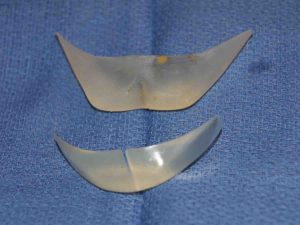
But like all implants used anywhere on the body, they are not complication-free. Mishaps and untoward outcomes do occur and secondary surgery is occasionally needed. Most of these problems are eminently improveable by implant adjustment or replacement and/or soft tissue modification.
Unhappiness with chin projection or shape after augmentation is a function of implant selection. There are now over seven styles of chin implants that offer more than a set amount of horizontal advancement. How far the implant goes back along the jawline and how much fullness to the side of the chin that is created can be altered by chin implant options that are now currently available. By comparison to the original operation, replacement with a new chin implant is a relatively easy operation since a pocket already exists. In some cases, a chin implant may have been asked to do too much. If the amount of forward chin movement needed is greater than 10mms, one may consider an osteotomy instead for such large chin changes. It will be prone to less potential complications.
Chin implants can shift as they are placed along a curved bone surface. Such shifting can occur horizontally or vertically. Most commonly, an implant that has shifted to the right or left is easy to spot as the central chin point is off-center. The center of the chin and its underlying implant should be along a vertical line drawn down from the center of the lower lip and through the midline between the mandibular central incisors. To prevent shifting during initial placement, a centrally-placed screw through the implant to the bone can be used. Similarly, correcting a deviated implant uses the same approach.
Vertical malposition (up too high) is usually the result of the implant being placed through an intraoral (inside the mouth) approach. With an open path from which it was inserted, it can easily slide up from the inferior border of the chin. It is more important to use a screw with the intraoral approach than from an incision under the chin where upward migration is limited by the superior extent of the pocket dissection during placement.
One of the newer complications of contemporary chin implants (anatomic designs) is lateral wing malposition. While it is usually a benefit to have the implant extend back further along the jawline, it is necessary to have these wings tapered to blend into the bone as the implant ends. This makes the wings very thin and extremely flexible. It is quite easy for them to fold or bend at the back end of the pocket during placement. This can be felt as a bend or fold along the jawline at the implant-bone transition. The implant must be removed, the pocket extended and the implant re-inserted.
One of the well known chin augmentation problems does not involve an implant at all. When a chin implant is removed for whatever reason, the expanded soft tissues may not shrink back down. If they do not, and the larger the original implant the less likely they will, the chin soft tissues fall creating the classic witch’s chin deformity. This can be corrected by refilling the collapsed space with a new implant or an advancement osteotomy. Another option is to remove the lax tissues and tighten them from underneath the chin. (a submental tuck-up)
Dr. Barry Eppley
Indianapolis, Indiana


